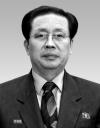Daily NK
Lee Sung Jin
4/24/2009
Hyesan, Yangkang Province: If it had been any other day, on April 18th the entire city would be buzzing with People’s Unit evaluation meetings and cadre lectures. On this particular day, however, influential officials in Yangkang Province, including Kim Kyung Ho, Chief Secretary of the provincial committee of the Party, were gathered together around the railroad tracks in Sungwoo-dong.
The “Ground-Breaking Ceremony” for a project to clear residences near the railroad, so as to fulfill “Supreme Commander Kim Jong Il’s March 4th Decree,” was being held. However, the expressions on the faces of the officials carrying out the decree were grim. The ceremony ended with a few civilians who had been mobilized for the event demolishing an old farmhouse near the railroad and without the top official present making the planned speech. The faces of the bystander officials as well as the gathered civilians betrayed their distress; removal of houses near the railroad has already started, while new homes for residents, whose houses are to be demolished, are not yet prepared.
All of this started with Kim Jong Il’s onsite inspections at Samjiyeon, also in Yangkang Province, on March 4th. Kim, who entered the county along the road connecting Bukchung in North Hamkyung Province and Hyesan, had some choice words for the homes haphazardly clustered around the railroad.
“Why is it so disorderly around here? Get rid of all of the houses surrounding the railroad within the year!”
He also apparently expanded on his beliefs, “Clearing the area around the railway is an important project which improves the image of our country.” Since Kim Jong Il’s words and “instructions” surpass all laws and institutions, his words immediately formed the “March 4th Decree” and were subsequently relayed to all officials in the Yangkang Province region.
Railways in North Korea
In North Korea, there is no protection surrounding railroads, which frequently cut across the center of cities. There are rules that prohibit the construction of public buildings, including residential homes, within 50 meters of railroad tracks, but such rules have existed in name only for a long time.
From the perspective of common citizens, the areas around the railways are some of the most active zones for economic activity. Of course, it is very dangerous when trains are passing, but since they run only once or twice a day at most, the danger is short-lived.
The railroad is a more direct route than the roads, which are in any case not always paved, so it helps conserve time for commuters or those going to markets. It is also convenient to travel on the rails on wooden blocks during the winter! In the border cities of Yangkang and North Hamkyung Provinces, railways running alongside the Yalu and Tumen Rivers serve as important smuggling routes to and from China.
Since the early 2000s, when citizens began to prefer convenient locations around railroads for selling goods or commuting to and from work, the North Korean authorities permitted the construction of residential homes, though bribes had to be offered to officials. In small and mid-size cities, many homes were built within 10 meters of railway tracks.
A source from Yangkang Province explained in a phone conversation with Daily NK on the 23rd while relaying the news of the groundbreaking ceremony, “Workers have to spend most of the year constructing homes. Many people will then be forcibly evacuated from the danger areas.”
The source further commented, “In Hyesan, several hundred households have to be relocated even if only the residential homes within 50 meters of the railway are demolished. Since land is available only on the outskirts of the cities, citizens slated for evacuation have been putting up strong resistance.”
The source also commented dryly, “In resettlement projects, homes are usually built very sloppily. It would be better if the state provided resources to the individuals to build the homes themselves.”
In the areas surrounding the railroad in Hyesan proper, where one-bedroom rentals by university students recently discharged from the army are commonplace, frustration has been running high. The source relayed that while the People’s Units around the railways have been holding daily meetings to decide on the households to be relocated, angry words and even fistfights have been rampant, making mutual agreement difficult if not impossible.
The Party in Hyesan allotted responsibility for the construction of new residences to each factory and enterprises. However, the construction materials provided by the North Korean authorities amounted to just 300kg of cement, which is barely enough for the under-floor heating of a house. Additional materials and means of transportation have to be provided in their entirety by the factories and the enterprises.
Even the citizens who do not live in the vicinity of the railways are incensed by the recent decree. Each household in Hyesan was ordered to make and offer 500 bricks of mud and straw. The factories, in order to secure fuel and other materials, have had to reduce the wages of workers, which at best are not even equivalent to two kilograms of rice, by half.
The source explained, “In 1992, 1,000 homes were built for the discharged soldiers who had been stationed in the Hyesan mine, but in less than three years, at least half had abandoned their homes. Residential homes built in Potae-ri, Samjiyeon or in Daehongdan look great on the outside, but they were all built sloppily, so the soldiers are living in poor conditions to this day.”

